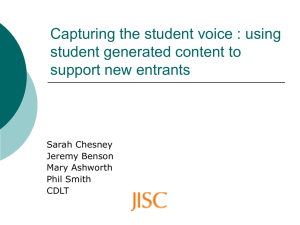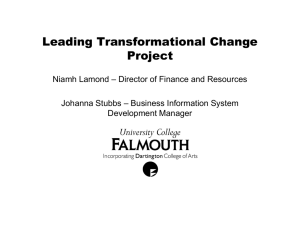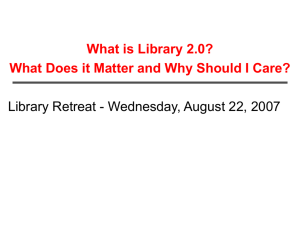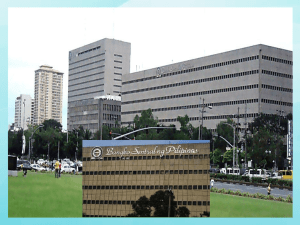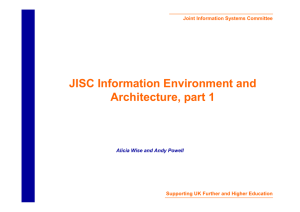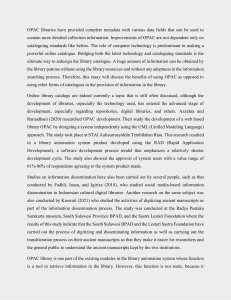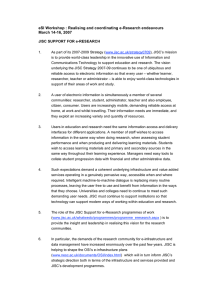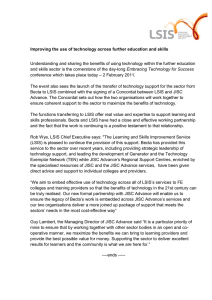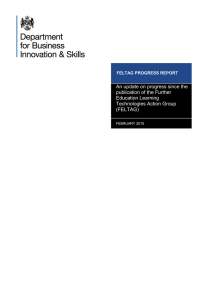NickWoolley
advertisement
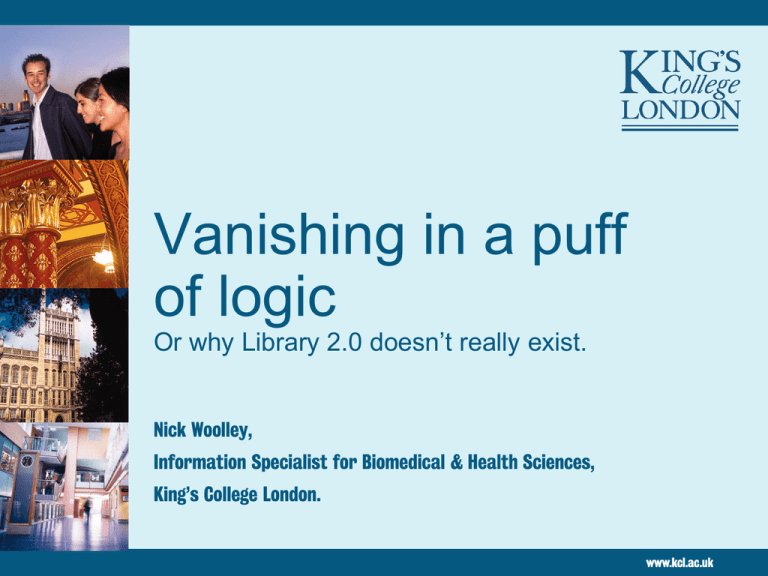
Vanishing in a puff of logic Or why Library 2.0 doesn’t really exist. Nick Woolley, Information Specialist for Biomedical & Health Sciences, King’s College London. AACR2 bibliometrics cataloguing citation classification communication dewey decimal labels information maps MeSH marc21 architecture metadata ontology OPAC referencing signage subject headings taxonomy thesaurus user guides web ironic tag cloud #1 2 Library 2. what? Does it actually mean something or not? If it does, what is it? If it doesn’t – or it’s down to the individual – then there’s not much point is there? And don’t we (librarians and assorted information professionals) have an ongoing vested interest in choosing the right words? 3 Looking at Library 2.0 4 Voice of doom? Or voice of reason? Be critical Good ideas will survive and flourish We have NOT been critical Reflect What do you do already? Look for evidence Does it really exist? What do we do already? What have we done? 01/09/2006 Library Journal “Library 2.0 : service for the next-generation library” “The heart of Library 2.0 is user-centered change.” “While not required, technology can help libraries create a customer-driven, 2.0 environment.” “.. the Library 2.0 model gives library users a participatory role in the services libraries offer and the way they are used..” “The Library 2.0 model seeks to harness our customer's knowledge to supplement and improve library services.” “What makes a service Library 2.0? Any service, physical or virtual, that successfully reaches users, is evaluated frequently, and makes use of customer input is a Library 2.0 service. Even older, traditional services can be Library 2.0 if criteria are met. Similarly, being new is not enough to make a service Library 2.0. http://www.libraryjournal.com/article/CA6365200.html 5 2007 re-evaluation “Library 2.0 is user-centric. It is a shift in our focus from having libraries decide what is best for users to letting users decide what they want, how they want to get it, and how we can best serve them. Library 2.0 is constant change and evaluation. Library 2.0 is not just about technology. Library 2.0 is political.” http://www.librarycrunch.com/2007/10/we_know_what_library_20_is_and.html 6 A synthesis Library 2.0 is about.. ..Web 2.0 / User participation / Constant change ..wisdom of crowds ..perpetual beta ..let the users decide It is represented as a paradigm shift to the next-generation of library services 7 Library 1.0? The Library 2.0 corollary is inescapable. It is an implicit de facto damning critique of Library (1.0) This critique is rarely articulated in any detail. When it is (peripherally) mentioned no evidence is provided. Is your Library 1.0 really so broken it needs ‘2.0’? 8 Library 1.0? “..a strict definition of Library 1.0 would be counterproductive. .. Library 1.0 really is whatever point you are at now. I think that what we need to remember is that Library 1.0 is a restrictive place, governed by strict hierarchies, rigid boundaries, and underpinned by changeavoidance.” Michael Casey (2005) http://www.librarycrunch.com/2005/10/is_there_a_library_10_does_it.html 9 “Even older, traditional services can be Library 2.0 if criteria are met.” “Your library may already offer some services that can be considered Library 2.0. If your organization combines these Library 2.0 options with a framework for continual change and customer input integrated into other operations within your library, it will be well on its way to becoming Library 2.0.” Michael Casey (2005) http://www.librarycrunch.com/2005/10/is_there_a_library_10_does_it.html What does this mean? How exactly is this helpful? Doublespeak? 10 Dave Pattern’s Library 2.0 generator http://www.daveyp.com/cgi-bin/l2/ideas.pl 11 http://www.physics.nyu.edu/faculty/sokal/transgress_v2/transgress_v2_singlefile.html 12 Sunglasses and moonlight Dawkins quoting Medawar in a Nature review of Sokal and Bricmont’s “Intellectual imposters” Nature 1998 394 141-143 “I could quote evidence of the beginnings of a whispering campaign against the virtues of clarity. A writer on structuralism in the Times Literary Supplement has suggested that thoughts which are confused and tortuous by reason of their profundity are most appropriately expressed in prose that is deliberately unclear. What a preposterously silly idea! I am reminded of an air-raid warden in wartime Oxford who, when bright moonlight seemed to be defeating the spirit of the blackout, exhorted us to wear dark glasses. He, however, was being funny on purpose.” 13 http://www.flickr.com/photos/bacigalupe/385042878 Technology and the library 14 Text Sumerians 3000 BC Clay tablets, papyrus, scrolls Alexandria (300 BC) Parchment, rolls, codex The printed book Classification Card Index Microform Computers Barcodes OPACs Internet and the WWW Online databases Digitisation, Ejournals, Ebooks RFID Web 2.0 The adoption of new technologies to improve the services we offer is characteristic of libraries in historic and contemporary settings. Web 2.0 may be another milestone along the way. But don’t confuse a comma for the start of a new chapter. 15 Library 2.0 does not replace 16 Bibliographic databases OR Google Scholar RefWorks OR Connotea E journals, reference works OR Wikipedia Experts OR Users IT literacy OR Digital natives pre-Library 2.0 change 17 library card index OPAC paper abstracts online databases print electronic photocopier pdf’s memory stick personal card index ref. man. software Nothing I do is Library 2.0 #1 But what I do at work includes… …promoting Web 2.0 tools like Delicious and Connotea …creating / participating in / advising on wikis …teaching RSS …continual response to user feedback …continual development of services and change 18 Nothing I do is Library 2.0 #2 But what I do (not) at work includes… …playing on facebook …tagging my books on LibraryThing …contributing to Wikipedia when I can bear it …using Bloglines to subscribe to my own increasingly bizarre Yahoo pipes mashed feeds… 19 http://www.flickr.com/photos/pollyalida/1717077674 Going to the users? 20 Library 2.0 says go to the users But we already are ‘everywhere’ And do the users want us in their space? http://education.guardian.co.uk/link/story/0,,2202291,00.html 21 The OPAC is broken? “I’ve visited Kings in Australia, and their library is absolutely massive. They’ve got a new computer system, and if you’re looking for a certain book, you just type in the book, and it comes up with the code, the floor, and where you can find it on that floor. It’s really cool.” (p.18) JISC Student Expectations Study July 2007 http://www.jisc.ac.uk/publications/publications/studentexpectations 22 JISC Student Expectations Study July 2007 [Comment on Second Life] “That’s a bit weird, to be honest. You would be quite sad to do that” (p.13) I don’t know if I would particularly like getting texts from the university. Because your phone is your private, social thing. (p.28) “..they do not want technology to encroach on their learning or social experiences. (p.29) “Fundamentally, this age group suspects that if all learning is mediated through technology, this will diminish the value of the learning.” (p.30) http://www.jisc.ac.uk/publications/publications/studentexpectations 23 http://www.flickr.com/photos/richard_am/116775447 Digital natives? 24 Want to learn from experts Want VFM Competitive Busy enough Want more ‘Library 1.0’! So… …Library 2.0 does not describe anything new …in fact it doesn’t really exist …this doesn’t mean we haven’t got a lot of work to do …this doesn’t mean we shouldn’t embrace the best of Web 2.0 …let’s keep on changing, improving, and ignoring any… 25 bandwagons buzzwords doublespeak extraordinary popular delusions and the madness of crowds fads groupthink hype imposters mumbo-jumbo oxymorons plus ça change self-referential slippery vanguardism weasel words ironic tag cloud #2 26
